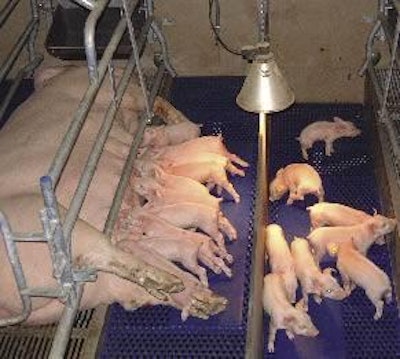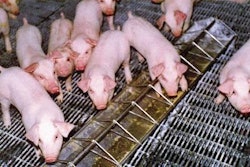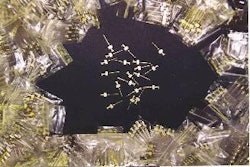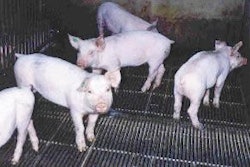
To understand the rationale behind some of the displays in the pig halls of EuroTier, visitors to the November exhibition in Germany should first know a little about German pork production in 2006. The bare statistics show only that Germany can claim to have the largest on-farm numbers in the 25-nation European Union, even if its national inventory in May this year was 1.5% smaller than 12 months previously at 26.5 million pigs.
A fact worth remembering in this connection is that the average German herd nationally now has 150 sows, still relatively small by international standards, although the structure is much more concentrated in the region of Niedersachsen or Lower Saxony around Hannover and in eastern areas of the country. Picture the typical sow unit nationwide as a piglet producer, selling its young pigs to another producer for growing and finishing, suggests Hans Hoevink, export manager at German equipment company Mannebeck. Weaning could be at 3 weeks or 4 weeks.
According to Mr Hoevink and his colleagues, the farrowing places of the typical German herd will use a crate that is angled diagonally across a pen measuring 2.4 metres long and 1.8 metres wide. The crate itself is probably 2.2m in length and 170cm wide. It may stand over a floor section of stainless steel or cast-iron under the sow, whereas the piglets almost certainly are on plastic-slat flooring. The heated zone of their creep area will be between 0.5-0.7m2 in size and could be warmed by electricity or by warm water.
A simple and cheap drop dispenser is often the choice to feed nursing sows in Germany where just one type of diet is given, but it is possible to find 2-dispenser installations on some farms offering dual diet types. Electronic feeding systems are gaining popularity elsewhere because of their positive effect on feed intake. The point to note about the German farrowing pen, however, is the high quality of materials used in construction, whether this is the galvanised steel of the crate or the stainless steel of the trough.
(Continued on page 14)
The weaned sow will be used in a single stall for mating. The Mannebeck company team cites standard stall dimensions as 2m long and 1.1m high, with a width of 70cm for sows or 65cm for gilts. Every stall will have an insemination door to the rear and a stainless steel trough under a feed dispenser in the front. Germany is in line with European legislation and practice by allowing the sows to stay in these stalls for up to 4 weeks before they move into group gestation. Both changing (dynamic) and stable-composition group systems can be found for the pregnancy period on German units. The stable-group versions tend to have just 10-15 sows at a time. Larger systems use a feeding station in many cases, although there are some producers who have chosen the alternative of giving feed in a line of free-access crates with automatic rear gates backing onto the communal lying area.
Space allowances in gestation usually relate to group size. Sows in small groups will probably receive 2.25m2 of floor area each, dropping to 2.025m2 if the group yard holds more than 40 sows. For gilts, the equivalent measurements are 1.80m2 dropping to 1.62m2 in over-40-pigs cases. Note also in Germany that both dry and liquid feed possibilities have many supporters, Mr Hoevink's colleagues explain. Dry feed is seen as extremely functional, user-friendly and adaptable to any situation. Its chief disadvantages are reckoned to be the initial cost and limitations to the practical length of the system. By comparison, liquid (wet) feeding has proved attractive for larger units and it normally gives lower feed costs as well as yielding more control-data information for management. It is called poorer than dry feeding on aspects of hygiene and it demands a better knowledge to run it effectively.
Today in Germany, though, the future of liquid feeding has become a highly topical issue. Other countries of Europe were stopped some years ago by European Union legislation from feeding any catering/restaurant waste food products to their pigs. While German producers at the time were granted a derogation to continue because so many of them relied on including by-products in their wet diets, that loophole is due to be closed in the last part of 2006. The question then will be whether liquid feeds will remain as popular nationally once the access to low-cost ingredients has been removed by law.
Better performance from bigger herds
An analysis of recordings by one of Germany's largest pig producer groups backs the thesis that the bigger the sow herd, the better the management. That at least was the conclusion reached by Erzeugerring Westfalen (ERW) after checking the figures for 260 units. The larger herds in this study contained 216 sows on average, compared with an average of 126 sows for members of the smaller category.
ERW's analysts also detected a difference between them for weaning age. A tendency to wean at 4 weeks in the relatively small units contrasted with a preference for 3-week weaning among the bigger players. As Table 1 reveals, the lower weaning age brought the rewards that might be expected, in the form of more litters per sow/year (2.40 against 2.22) and more piglets weaned per sow annually (23.4 against 20.9). But ERW piglet production expert Reinhard Hinken is quick to emphasise how it is the management that counts most in this respect.
"I would say that the influence of the herd size on production is very much larger than any effect the length of suckling period might have," he comments. "Generally, the bigger the unit, the more specialisation there is with all the advantages this brings in herd management, animal health and the standard of buildings and equipment."
Even the figures for liveborn pigs per litter in the group's comparison (11.3 and 11.0 respectively) gave the edge to the 3-week weaners, despite the shorter regeneration period for the sows. Nor did the higher productivity of these sows affect their survival adversely. Sow losses of 4.2% on 3-week weaning compared with 5% for the 4-week weaners. Further backing for Mr Hinken's thesis that big herds generally mean better management came from the piglet mortality figures in the analysis. The larger herds averaged of 13.7% losses up to weaning, whereas the smaller ones returned an average of 14.2%. Nursery deaths up to 30kg liveweight also were 0.5 percentage points lower, at 2.6%. Only in returns to first service did the 4-week farms outperform the others, recording 40.8% compared with 41.2%.
The Erzeugerring study of its members' 2004/2005 results looked additionally at the influence of the weaning regime on feed consumption. Naturally, sows ate more on average when weaning was at 4 weeks (1.2 tons against 1.18 tons). But having one week shorter in the nursery period up to 30kg meant the 4-week herds gained in that their pigs each consumed 38.5kg during this time, while the 3-week weaners ate 39.5kg. Norman Dunn
On line for optimum carcase production - Health experts consider disease prevention
Another interdisciplinary approach in the German pig sector features electronic recording and on-line control in a programme now covering 5 million pigs per year (Norman Dunn reports). Ten years of research and steady growth have gone into Infosys, now rated one of Germany's most successful integrated pig production quality systems. Five major slaughterhouses with automated Auto-FOM carcase classification are involved and around 10% of the country's 46 million pigs produced annually go through the scheme.
"Around 60 000 of these pigs each year are tagged with Radio Frequency Identification (RFID) chips," reports Peter Schwaer from the administering company Infosys Tierdaten-Service. "This electronic tagging means we can link results of veterinary inspections on the slaughter line with conditions on the farms of origin to guide us in overall production. Results from the electronically tagged pigs are also applied in breeding research."
Using the results to fine-tune farm routine certainly pays. In 2004, Infosys returns showed that pigs passed by the veterinarian as clean in the abattoir had been an average of up to a 50 grams better for daily liveweight gain while on the farm, compared to those found with faults for liver or lungs. Carcase conformation data for each pig are available to the individual farmer usually within 2 working days after slaughter. At the same time, all the facts enter a central databank and can also be passed along to the respective veterinary practices and farm advisory services.
"Here," points out Peter Schwaer, "is where the multidisciplinary discussions between the producer, his veterinary adviser, the breeding company, feed manufacturer, ventilation experts and so on come into play. It is when the results are used to push forward improvements."
The information on line comes in tabular and graph forms, both for batch-by-batch comparison and for benchmarking against the average results for that slaughterhouse over a period of up to 3 months. Just one example of the comprehensive analyses features a bar-chart series showing distribution of 16 carcase characteristics per shipment, from slaughter weight through to the size and weight of primary cuts such as shoulders or hams.
Participating in this programme are 5 of the largest slaughtering and processing organisations in Germany. The cost of such control is relatively low even zero in some cases. In 2006 the individual producer member pays a flat 75 into the scheme, no matter how many pigs are sent to slaughter. But one forward-thinking processor actually pays the whole Infosys bill for its farmer-suppliers. It has explained, "The high standard of control and possibilities for fine-tuning production never fail to guarantee extra returns for us in processing efficiency and customer satisfaction."
In a year when the northern part of Germany has had its problems with classical swine fever (hog cholera), it is worth mentioning the establishment of a group of German specialists who aim to take an all-round look at pig disease and its prevention considering aspects from farm production to veterinary policies. This year's EuroTier exhibition in Hannover will feature the group's first public presence at such an event, including a presentation forum on its first year's work.
It sees the way forward as taking the interdisciplinary route towards solving health problems. "Perhaps too often in the past, each specialised segment within the pig sector has not involved the other players when discussing problems and plans," says Professor Thomas Blaha, director of Hannover University of Veterinary Medicine's Bakum outstation and first chairperson of new German pig health society DGSG. "We are involving not only veterinary experts, but also those who know about pharmaceuticals, buildings and feeding and, of course, the farmers themselves. Already we have established the first expert committees to look at as many influences as possible on pig health and subsequent production quality, from the constituents of the feed to aspects of breeding and hygiene."
The society's starting membership of 46 people has included several corporate or group representatives; in other words, someone who has joined on behalf of a pig producers' co-operative, a pharmaceutical company or a breeder. Deputy chairperson Birgit Scharlau herself represents thousands of piglet producers and feeders through her position as board member of the 12 000-member 'producer interest network' ISN.
Themes under investigation by the DGSG working committees range from food safety to animal welfare. One committee has the brief of deliberating ways to control animal disease epidemics. With the last swine fever episode in mind, this multi-skilled assembly has already held a national conference on the subject at the end of last year. Its official title could have been translated literally as After the epidemic is before the epidemic', Professor Blaha remarks. But the real meaning summed up the DGSG consensus by implying that we should all learn from our experiences and start preparing immediately on having better, more integrated policies against the most serious pig diseases.

















